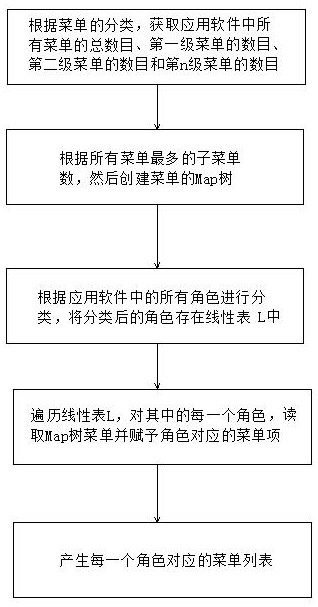HashMap-based multi-way tree generation method
A multi-fork tree and menu technology, applied in database indexing, special data processing applications, structured data retrieval, etc., can solve problems such as low query speed and affect work efficiency, so as to speed up query speed, improve work efficiency, and save system resource effect
- Summary
- Abstract
- Description
- Claims
- Application Information
AI Technical Summary
Problems solved by technology
Method used
Image
Examples
Embodiment 1
[0038] see figure 1 , a method for generating a multi-fork tree based on HashMap, comprising the following steps:
[0039] a. According to the classification of menus, obtain the total number of all menus in the application software, the number of first-level menus, the number of second-level menus, and the number of n-level menus, and then create a menu according to the maximum number of submenus of all menus The Map tree;
[0040] b. Classify all roles in the application software, and store the classified roles in the linear table L;
[0041] c. Traversing the linear table L, for each role in it, read the Map tree menu and assign menu items corresponding to the role, and finally generate a menu list corresponding to each role.
[0042] "a. According to the classification of menus, obtain the total number of all menus in the application software, the number of first-level menus, the number of second-level menus, and the number of nth-level menus, and then create Map tree o...
Embodiment 2
[0044] see figure 1 , a method for generating a multi-fork tree based on HashMap, comprising the following steps:
[0045] a. According to the classification of menus, obtain the total number of all menus in the application software, the number of first-level menus, the number of second-level menus, and the number of n-level menus, and then create a menu according to the maximum number of submenus of all menus The Map tree;
[0046]b. Classify all roles in the application software, and store the classified roles in the linear table L;
[0047] c. Traversing the linear table L, for each role in it, read the Map tree menu and assign menu items corresponding to the role, and finally generate a menu list corresponding to each role.
[0048] In the step a, creating a Map tree of the menu includes:
[0049] S1. First query the data of the menu;
[0050] S2. Put the data of the menu into the Map, the key is the menu ID, and the value is the reference of the menu data;
[0051] S...
Embodiment 3
[0057] see figure 1 , a method for generating a multi-fork tree based on HashMap, comprising the following steps:
[0058] a. According to the classification of menus, obtain the total number of all menus in the application software, the number of first-level menus, the number of second-level menus, and the number of n-level menus, and then create a menu according to the maximum number of submenus of all menus The Map tree;
[0059] b. Classify all roles in the application software, and store the classified roles in the linear table L;
[0060] c. Traversing the linear table L, for each role in it, read the Map tree menu and assign menu items corresponding to the role, and finally generate a menu list corresponding to each role.
[0061] In the step a, creating a Map tree of the menu includes:
[0062] S1. First query the data of the menu;
[0063] S2. Put the data of the menu into the Map, the key is the menu ID, and the value is the reference of the menu data;
[0064] ...
PUM
 Login to View More
Login to View More Abstract
Description
Claims
Application Information
 Login to View More
Login to View More - R&D
- Intellectual Property
- Life Sciences
- Materials
- Tech Scout
- Unparalleled Data Quality
- Higher Quality Content
- 60% Fewer Hallucinations
Browse by: Latest US Patents, China's latest patents, Technical Efficacy Thesaurus, Application Domain, Technology Topic, Popular Technical Reports.
© 2025 PatSnap. All rights reserved.Legal|Privacy policy|Modern Slavery Act Transparency Statement|Sitemap|About US| Contact US: help@patsnap.com

